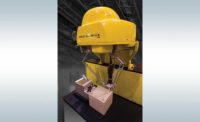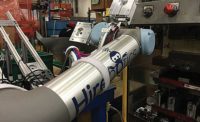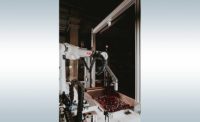The popularity of cordless tools on the assembly line continues to grow. Battery-operated devices allow assemblers to more easily work on platforms or inside car interiors, tractor cabs, aircraft wings and other tight spaces.
Cordless tools also improve safety and increase quality. There are no air hoses and electrical cords to trip workers or scratch paint jobs. That’s why they’re the fastest-growing segment of the power tool market.
Battery-powered fastening tools have been around since they were first invented for use by NASA astronauts 50 years ago. Although they quickly found a niche with homeowners and contractors, assembly line applications have been more limited.
But, that’s starting to change. Assemblers in many industries, especially automotive, aerospace and off-highway equipment, are cutting the cord. And, in some cutting-edge plants, only cordless tools are allowed.
Batteries now last longer, weigh less, cost less and recharge quicker. In addition, the torque capabilities of cordless tools have increased and maximum speeds now match many air tools.
The latest generation of cordless fastening tool technology boasts more accurate torque, repeatability and dependability than ever. In addition, wireless traceability and network integration is now the rule rather than the exception.
Cutting the Cord
Cordless tools are now quieter and more economically viable than many alternatives, such as traditional air tools. Today’s devices are more durable and much cheaper to operate on assembly lines. According to some estimates, they can save up to 95 percent in energy costs compared to air tools.
“There’s still a need for traditional, pneumatic tools, but we see a lot of manufacturers moving toward quieter plants,” says Eric Dees, director of global assembly tools at Ingersoll Rand. “Some of them are committing to full battery platforms.
“It’s primarily due to the intangible costs around safety,” explains Dees. “Insurance costs can be lower when there’s a reduced risk of trip hazards and a reduced need for ear protection.”
“The torque capabilities of cordless tools have increased and maximum speeds now match air tools,” claims John Bradford, senior sales engineer at Bosch Production Tools. “This was a big sticking point for many engineers in the past.
“Trying to convince their operators that using a slower tool that did not have an air hose attached was a good thing was sometimes difficult,” says Bradford. “Engineers today would like as many of their assembly tools as possible to be cordless.”
Operator safety and ergonomics are important cordless tool benefits that appeal to many manufacturing engineers.
“They don’t want cords on the factory floor,” says Anthony Zimmerman, global product manager for cordless tools at Apex Tool Group LLC. “In fact, some companies now specify that if a battery-powered tool will do the job, it must be selected over a corded alternative.”
Sometimes, age can be a factor in the appeal of cordless tools.
“The younger generation seems to embrace new technology,” notes Russ Hughes, threaded fastening technology marketing manager at Desoutter Industrial Tools. “[Some engineers who] have been around longer just need more time to prove it out and accept the change. Others will always underestimate a cordless tool’s capability.”
Desoutter’s newest cordless production tool is the BLRT, a transducerized pulse tool. The lightweight device features high speed, no torque reaction and a clear OLED display. Its currently only in use at three auto plants, but the tool will be formally launched at the ASSEMBLY Show in late October.
According to Hughes, the new battery-powered tool was designed with operator ergonomics in mind. “Unlike other pulse tools, we don’t use a hydraulic pulse mechanism,” he points out. “We just use a robust gear set to do all the pulsing. We also use lightweight materials, such as aluminum, composites and titanium.
“In addition, new algorithms are always being developed to help reduce operator injuries and fatigue,” says Hughes. “We have one built into all our products, including cordless tools. We call this ERGO stop. It reduces the affect the operator feels when the tool shuts off. We gradually release the tool to prevent reaction to the operator.”
As cordless technology has evolved, tool suppliers have been able to improve their products. That’s made it easier to convince manufacturers to invest in the devices.
“Engineers now see the advantages of cordless tools for assembly applications,” says John Olson, power tool group manager at Panasonic Eco Solutions Co. North America. “The drawbacks cordless tools had 10 years ago have now been overcome. There is a definite change in attitude in the industry, and many engineers now see cordless tools as being the future of assembly.”
According to Olson, automotive assembly plants that may have had 100 or less cordless tools a decade ago now have more than 1,000.
“Many agricultural and construction equipment manufacturers have also been eager to adopt battery-powered fastening tools,” he points out. “Another industry that’s hungry for cordless options is aerospace.”
Traditionally, cordless tools were primarily used for non-safety critical automotive applications, such as attaching door trim and instrument panels. But, that’s quickly changing.
“OEMs and suppliers are now willing to use cordless tools for applications that would have been performed with a DC tool in the past,” says Dees. “This includes powertrain, in addition to air bags, brakes and steering systems.”
“Cordless tools are now used for all kinds of joints,” adds Manoj Malhotra, global marketing manager for the power tools group at Apex Tool Group LLC. “The only limitation is torque.
“The torque threshold for most cordless tools is now around 105 newton-meters,” notes Malhotra. “In the past, engineers typically specified either electric or pneumatic tools for any fastening application that required a torque of 50 newton-meters or higher.”
Today’s offerings are much faster and more durable than what was available just a few years ago. Back then, cordless tools often had brushed motors, analog switches and nickel-cadmium or nickel-metal hydride batteries with limited charge cycles.
“Cordless tools were fairly high maintenance and lacked the speed, durability and run times to keep up with modern takt times,” says Olson. “And, there were few wireless traceability systems.
“In the past, manufacturers viewed cordless assembly tools as high-maintenance items,” Olson points out. “They would often go through a lot of brush motors and switches, making them expensive to own and operate.
“Many of the earlier cordless tools used direct-drive motors, which ran slower,” adds Olson. “They couldn’t keep up with the pace of their air-tool counterparts.”
New Technology
State-of-the-art cordless tools feature brushless motors and high-capacity lithium-ion batteries for higher durability.
Working in conjunction with Toyota Motor Co., Panasonic engineers developed pulse tools that feature hybrid switches, resulting in almost no mechanical failures.
For instance, the company’s EYFGB Series of cordless clutch tools use a hybrid switch that allows the higher current draw of the motor and brake to be controlled by a separate circuit, bypassing the switch altogether. Because the hybrid switches have only 0.5 amp going through them, compared to 25 or 30 amps in conventional switches, the contacts last much longer.
Panasonic’s newest product offerings are the EYFNA1PR and EYFPA1JR mechanical pulse tools. “They are [the only] cordless tools in their torque range that have no reaction and advanced error proofing with networking capability,” claims Olson.
By utilizing wireless communication and connecting the tools to a Panasonic assembly qualifier, batch counting and line control can be incorporated to prevent defects from moving down the assembly line.
The pistol-grip tools feature advanced error-proofing capability via an enable and disable feature. At each workstation, they receive a signal to turn on, which enables the operator to only install a certain number of fasteners. After they are installed, the tool is disabled to prevent errors or defects.
“That tool can’t be used at another workstation on the assembly line or elsewhere in the factory,” says Olson. “We can do that to an individual tool or an entire group of tools.”
To prevent loose or under-torqued fasteners, a CPU monitors the output torque of the tool. If the torque falls below the selected value due to battery power, the CPU automatically adjusts the tool to deliver the correct power, which makes the tool very accurate and repeatable.
“As the operator runs the tool, the CPU monitors the battery level and when the battery no longer has enough power to reach the required torque, the CPU automatically shuts down the tool to prevent under-torqued fasteners,” explains Olson.
Although Panasonic only offers pistol-grip tools, it’s currently in the process of developing a line of right-angle tools, which are popular for applications that require reach or easier access to tight places.
Better Batteries
Battery technology has also improved in recent years. For instance, energy density of lithium-ion batteries has increased, which allows longer run times without increasing the size or weight of the power pack.
New battery chemistries allow faster charge times and more charge cycles during the life of the batteries. In fact, some 2 ampere-hour batteries are now the same size and weight of 1 or 1.5 ampere batteries of just a few years ago.
Despite those advances, some engineers still need to be convinced about the benefits of cordless tools.
“There is definitely a learning curve that needs to be overcome,” says Cecil Morgan, applications engineer at DEPRAG Inc. “In the past, battery tools had a bad reputation, which was mainly because of the battery life and the time it took to recharge.
“[To address that], we package each of our cordless tools with one charger and two batteries each, so that there is hopefully always one battery fully charged and the other battery is charging,” adds Morgan. “We have also reduced the recharge time to below 40 minutes for a full charge.
“Longer battery life and quicker charging are important in all cordless tools, but we see the importance of accuracy, flexibility, documentation, analysis and traceability as the future of cordless production tools,” notes Morgan.
“With the latest generation of batteries, we’re able to run longer at higher torques,” says Ingersoll Rand’s Dees. “And, as the battery begins to lose its charge, you no longer see dramatic drops in performance.”
Last month, Ingersoll Rand unveiled its QXN line of cordless tools, including pistol grips and right-angle wrenches.
“The simple, cost-effective tools provide programmable torque control, traceability and gang count capabilities that ordinary clutch tools can’t,” claims Dees. “They store data, identify errors, validate production and support troubleshooting.
“The QXN tools can be programmed to achieve specific torque, gang counts and degree of rotation right down to detecting cross-threads and stripped fasteners,” adds Dees. “They employ closed-loop transducers to provide the highest level of traceability and ensure that the tool is delivering the specific torque required.”







